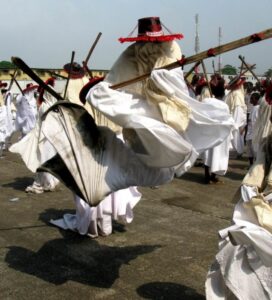By Amarachi Ezeah , Ogechi Ezeagba, Ngozi Ezeala
The Eyo Festival, otherwise known as the Adamu Orisha Play, is a Yoruba festival unique to Lagos, Nigeria, with strong historical ties to Iperu-Remo, a town in Ikenne Local Government, Ogun State. In modern times, it is presented by the people of Lagos as a tourist attraction. Due to its historical development, it is traditionally performed on Lagos Island.
The word “Eyo” also refers to the costumed dancers, known as masquerades, that appear during the festival. The origin of this observance is linked to the inner workings of the secret societies of Lagos. On Eyo Day, the main highway in the heart of the city , which is from the end of Carter Bridge to Tinubu Square is closed due to traffic, allowing for a grand procession from Idumota to the Iga Idunganran Palace. The white-clad Eyo masquerades represent the spirits of the dead and are referred to in Yoruba as “agogoro Eyo” which is the “tall Eyo”.
The first recorded Eyo procession in Lagos took place on February 20, 1854, in honor of Oba Akitoye. The festival serves as a tribute to an Oba’s life and is traditionally held to mark the passing of a ruler or the election of a new one. Over time, it has also been organized to honour the death of notable individuals or to celebrate special occasions, such as visits by heads of state.
During the festival, all participants pay homage to the reigning Oba of Lagos. While the event is deeply rooted in tradition, it is now also a major tourist attraction, generating significant revenue for both the government and small businesses around Lagos Island. The festival is one of the few occasions when traditional rulers and nobles exercise their cultural influence.
The Eyo Masquerades Take Over the Streets Of Lagos
There are two main types of Eyo masquerades:Adimu Orisha Eyo, which represents the spirits of the dead and the Eyo Olokun, which is associated with the sea god, Olokun. Both types hold unique symbolic significance in Yoruba culture.
The Eyo masquerade consists of performers dressed in flowing white robes, with their faces and heads covered by papier-mâché or cloth masks. They carry long sticks and wear hats adorned with brightly colored tassels. Their movements are slow and graceful, each step synchronized with rhythmic drumming.
The Eyo Festival is a major event that attracts visitors from across Nigeria and beyond. The masquerades dance and perform in the streets, accompanied by drumming and singing.
Several taboos are associated with the Eyo masquerade, like Women not being allowed to look directly at the masquerade. It is considered disrespectful to touch or speak to the masquerade during its performance and seeing the masquerade without permission is believed to bring bad luck.
In Yoruba culture, the Eyo masquerade symbolizes respect for ancestors and is believed to bring good luck and blessings to the community. It also serves as a symbol of unity and solidarity among the people.
The Eyo masquerade has been widely represented in society and films. In Yoruba communities, it is revered as a sacred figure, appearing only during special occasions. During the annual Eyo Festival in Lagos, the masquerades parade through the streets, filling the city with drumming, singing, and celebration.
In Nigerian films, the Eyo masquerade is portrayed in different ways, sometimes as a mystical and powerful figure, and other times as a symbol of tradition and cultural heritage. For instance, in the Nigerian film Eyo Festival, the masquerades are depicted as respected and powerful figures, strengthening the festival’s cultural importance.
